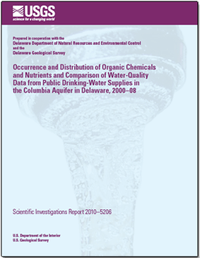The U.S. Geological Survey, in cooperation with the Delaware Department of Natural Resources and Environmental Control and the Delaware Geological Survey, conducted a groundwater-quality investigation to (a) describe the occurrence and distribution of selected contaminants, and (b) document any changes in groundwater quality in the Columbia aquifer public water-supply wells in the Coastal Plain in Delaware between 2000 and 2008. Thirty public water-supply wells located throughout the Columbia aquifer of the Delaware Coastal Plain were sampled from August through November of 2008. Twenty-two of the wells in the sampling network for this project were previously sampled in 2000. Eight new wells were selected to replace wells no longer in use. Groundwater collected from the wells was analyzed for the occurrence and distribution of selected pesticides, pesticide degradates, volatile organic compounds, nutrients, and major inorganic ions. Nine of the wells were analyzed for radioactive elements (radium-226, radium-228, and radon). Groundwater-quality data were compared for sites sampled in both 2000 and 2008 to document any changes in water quality. One or more pesticides were detected in samples from 29 of the 30 wells. There were no significant differences in pesticide and pesticide degradate concentrations and similar compounds were detected when comparing sampling results from 2000 and 2008. Pesticide and pesticide degradate concentrations were generally less than 1 microgram per liter. Twenty-four compounds, 14 pesticides, and 10 pesticide degradates were detected in at least one sample; the pesticide degradates, metolachlor ethanesulfonic acid, deethylatrazine, and alachlor ethanesulfonic acid were the most frequently detected compounds, each found in more than 50 percent of samples. Almost 80 percent of the detected pesticides were agricultural herbicides, which reflects the prevalence and wide distribution of agriculture in sampled areas, as well the dominance of agricultural pesticides among the target analytes for this study. No concentration of a pesticide or pesticide degradate exceeded any regulatory standard. Dieldrin, an insecticide that has been banned for several decades, was detected at a concentration that exceeded a non-regulatory health-based screening level of 0.002 micrograms per liter at nine sites. Volatile organic compounds (VOCs) were generally detected at concentrations of less than 1 microgram per liter, although 7 of the 31 detected VOCs had concentrations greater than 1 microgram per liter. There were no significant differences in VOC concentrations from 2000 to 2008; however, among the resampled wells, the mean number of VOCs detected per well was significantly different over the 8-year period. The number of VOCs detected per well decreased in 73 percent of the resampled wells; the decrease ranged from one to eight fewer detections in 2008 than in 2000. Chloroform and methyl tert-butyl ether were the most frequently detected VOCs, at 90 percent and 63 percent, respectively, among the 30 wells. Solvents were the most frequently detected class of VOCs. All measured concentrations of VOCs in groundwater were below established standards for drinking water and below other health-based guidelines. There were no significant differences in nutrient or major-ion concentrations between 2000 and 2008, however, the medians of two field measurements, pH and dissolved oxygen, were significantly higher in 2008 than in 2000 in the resampled wells. Although pH and dissolved oxygen were higher, water was still acidic and predominantly oxic. Nitrate was the predominant nutrient species in the Columbia aquifer, with a 90-percent detection frequency. The median nitrate concentration in groundwater was 4.88 milligrams per liter, which was slightly lower than, but not significantly different from, the median of 5.23 milligrams per liter for the 2000 samples. Concentrations of nitrate exceeded the U.S. Environmental Protection Agency's Maximum Contaminant Level or Federal drinking-water standard of 10 milligrams per liter as nitrogen in samples from two wells. Eight of the 30 wells sampled had iron or manganese concentrations that exceeded the U.S. Environmental Protection Agency's Secondary Maximum Contaminant Level; nine samples exceeded the Health Advisory Limit set by the Delaware Division of Public Health of 20 milligrams per liter for sodium in drinking water. Two radiochemical isotopes, radium-226 and radon-222, were detected in all nine groundwater samples analyzed; five samples had detectable levels of radium-228 activity. None of the samples exceeded the U.S Environmental Protection Agency's Maximum Contaminant Level for radium or radon in drinking water. Although radioactive elements were more frequently detected in 2008 than in 2000, this increased detection frequency is more likely due to lower detection levels in 2008 than 2000. The average age of groundwater entering the screens of the production wells sampled in 2008 ranged from 6 to 35 years, with a median groundwater age of 22 years. Groundwater age was positively correlated with well depth and negatively correlated with dissolved oxygen. Data from the 22 resampled wells indicate a significant positive difference in the average modeled groundwater-sample-age results. The average groundwater age from samples collected in 2008 was generally 7 years older than the average groundwater age from samples collected in 2000.


